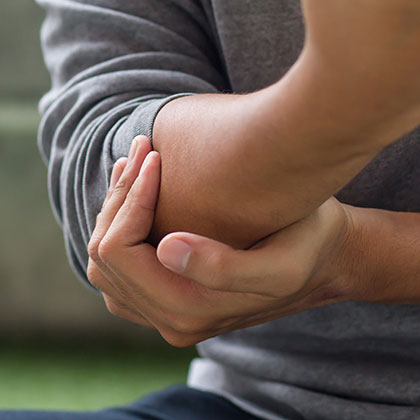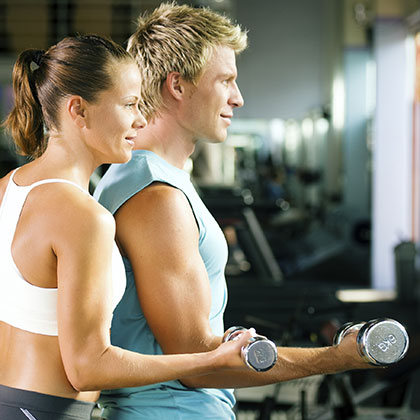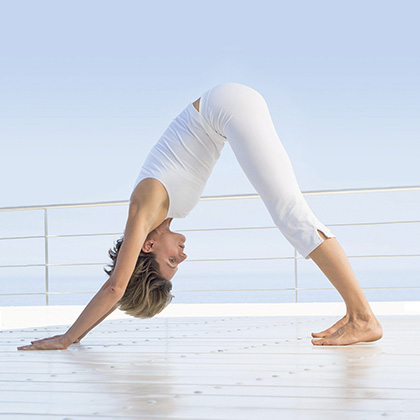The medical term is epicondylitis, but you may know this painful condition as golfer’s elbow (medial epicondylitis) or tennis elbow (lateral epicondylitis).
With golfer’s elbow, the inside of the elbow joint can feel painful, tender and possibly a little swollen, with the pain occasionally spreading down the forearm. Tennis elbow, on the other hand, causes pain on the upper forearm around the outer side of the elbow, sometimes also with pain in the back of your hand.
Both conditions may cause pain when you lift or bend your arm, when you open a jar or perform another twisting movement with your forearm, when you grip small objects such as a coffee cup or a pen or pencil, and when you try to straighten your arm. In some cases, the pain can be constant, even when you’re resting.
Both golfer’s elbow and tennis elbow are tendon overuse (or overload) injuries. Repeatedly bending your wrist – such as when holding a golf club – can cause golfer’s elbow.
However golf isn’t the only sport to cause it – sports that involve throwing such as baseball, softball or rounders can cause golfer’s elbow too, as well as weight training (if you’re not using the correct technique) plus everyday activities such as using a computer, painting, hammering or using vibrating tools, chopping wood and raking leaves.
Tennis elbow, meanwhile, is – as the name suggests – caused by playing tennis (though lighter tennis rackets and two-handed backhand techniques are thought to be making the injury less common in sportspeople).
It too can be caused by a number of other activities, including jobs that involve repetitive heavy lifting or the use of heavy tools, or activities where your hands are bent or twisted, such as wringing clothes or using a screwdriver. Importantly, don’t confuse tennis and golfer’s elbow with carpal tunnel syndrome, which tends to affect the writsts and hands instead.
How common is it?
Epicondylitis is thought to be more common in any age group (i). According to the Patient, tennis elbow affects an estimated 1 - 3 per cent of the population, with men and women affected equally (the most common age to develop tennis elbow is when you’re between 40 and 50 years old) (i). The symptoms most commonly last for between six months and a two years, though most people are better in under a year (ii).
Golfer’s elbow is thought to be about a fifth less common as tennis elbow, though it is the most common cause of medial (inside) elbow pain (i). Anyone can develop it, but it’s mostly seen in people aged between 40 and 60 years old (iii). The pain of golfer’s elbow can linger for months to years, or it may return or become persistent (iv). Often, other musculoskeletal conditions such as back pain can worsen the effects of elbow joint problems.
How the elbow joint works
The elbow joint is where the humerus (the bone in the upper arm) meets the two forearm bones (the radius and the ulna). The end of the humerus at this point has two bony prominences, called the lateral epicondyle – the outer bumpy part – and the medial epicondyle, the bony bit on the inside.
The lateral epicondyle is attached to muscles used to straighten the wrist and the fingers, called extensor muscles. These are connected to the brain and nervous system primarily through the radial nerve, which runs along the outside of the elbow.
The medial epicondyle is attached to muscles that you use to flex your wrist and fingers, called the flexor muscles. These muscles allow you to hold objects, and are connected to your brain and nervous system primarily via the median nerve, which runs in front of the elbow.
Altogether there are many muscles and tendons that make up the elbow joint and forearm. However, golfer’s elbow is thought to be caused by repetitive stress of the flexor muscles, causing pain in the tendons that attach the muscles to the medial epicondyle.
Tennis elbow, meanwhile, is caused by repetitive stress of the extensor muscles, including the extensor carpi radialis brevis (ECRB) muscle, causing pain in the tendons that attach the muscles to the lateral epicondyle.
Tendon thickening
Epicondylitis is generally thought to be an inflammatory process (when a medical terms ends with ‘itis’, it indicates the presence of inflammation). Straining the muscles and tendons in your forearm causes tiny tears and inflammation near the epicondyles. But some experts now believe it’s less to do with inflammation and more to do with a thickening of the tendon, which may be a reaction to overloading the muscles (i).
What most agree on, however, is that while golfer’s elbow and tennis elbow may be painful, they shouldn’t cause any lasting damage, such as arthritis.
Treatments for golfer’s elbow and tennis elbow
Despite the fact that golfer’s elbow and tennis elbow are common conditions, there is no single accepted treatment regime for either of them, and a number of treatments are often used (the treatments are the same or similar for both conditions). In many cases, both types of epicondylitis get better without any treatment – though some people may be affected for a long time.
Most importantly, if you have either golfer’s elbow or tennis elbow, you should stop doing whatever activities or actions are causing the problem and rest your arm as much as possible. If these activities are linked to your job, you may need to discuss different ways of working with your employer, as continuing to work in the same way will make the pain worse.
Cold therapy may also help reduce the pain
Apply an ice pack or a bag of frozen peas wrapped in a towel against your elbow for a few minutes several times a day (never apply ice directly to the skin as it could cause an ice burn).
Other treatments include the following:
Pain relief
The main type of pain relief used to treat epicondylitis is simple over-the-counter remedies, such as paracetamol or ibuprofen. An anti-inflammatory painkiller, ibuprofen is also available in cream or gel format, which you can apply directly to your elbow (these may be preferable, as they tend to cause fewer side-effects – including nausea and diarrhoea – than oral tablets).
Physiotherapy
If your golfer’s elbow or tennis elbow is causing more severe pain, you may be referred for physiotherapy. This may include massage and manipulation to encourage blood flow and help relieve pain and stiffness, as well as laser therapy and ultrasound therapy.
Your physiotherapist may also show you exercises that you can do at home to keep your arm moving and make the muscles in your forearm stronger (see How to prevent golfer’s elbow and tennis elbow, below, for examples of some exercises that may help). There’s evidence that physiotherapy may help relieve the pain of epicondylitis in the long term, but you may have to wait a while to get physiotherapy treatment on the NHS.
Supports and splints
You may also be advised to use a support bandage, splint or a brace on your elbow or wrist as a short-term measure. These may help support and protect your elbow and wrist joints until your symptoms start to ease.
Steroid injections
If you have difficulty using your arm, your pain is severe or you’ve tried physiotherapy and using supports without much success, your GP may recommend an injection of corticosteroids into the affected part of your elbow to ease the pain. But while studies suggest these injections are effective at first, the pain can return (i). If that happens, you may be advised to have a second or third injection – but doctors don’t usually give more than three steroid injections in the same place.
Shock wave therapy
Passing high-energy shock waves through the skin has been shown to improve the pain of other types of tendonitis – though this particular treatment may not work for tennis elbow (i). Shock wave therapy has been declared safe by the National Institute for Health and Care Excellence (NICE), but it can cause minor side effects such as bruising and reddening of the skin. It can also be a painful treatment, but a local anaesthetic can make it feel more comfortable. How many treatments you’ll need will depend on how bad the pain is.
Botox injections
In very severe cases, botulinum toxin A (commonly known as Botox) can be injected into the muscles of the forearm to treat epicondylitis. This treatment isn’t used very often, however, as it paralyses the muscles that move the third and fourth fingers for a few months.
Surgery
If you have really severe symptoms that don’t improve over time, you may be referred for surgery to remove the damaged part of the tendon. However, not many people are thought to require surgery for epicondylitis.
How to prevent golfer’s elbow and tennis elbow
If you’ve previously had golfer’s elbow or tennis elbow, the most important thing to do to prevent it recurring is to avoid or modify the activity that caused the pain in the first place. If your injury was caused by playing sports, you may need advice from a specialist sports coach to help you improve or change your technique to prevent any further problems.
Other things that may help include warming up properly before you start exercising or playing sport, and stretching your arm muscles after each session. Make sure any equipment you use – such as a tennis racquet, for instance – is lightweight and the correct size for your hands. You may also want to consider wearing sports supports on your wrists and elbows when you play.
Strengthening and stretching the muscles in your forearm may help avoid further injuries too. A physiotherapist is the ideal person to offer advice on which exercises you should do, and the correct techniques for doing them. In the meantime, here are some of the exercises you could try to help stretch and strengthen the flexor and extensor muscles:
Stretch
For golfer’s elbow
Place the palm of your hand against a wall, keeping your elbow straight (support it with your other hand). Feel the stretch along the front of your forearm and hold for about 30 seconds. If you want a more intense stretch, place your hand further up the wall. Repeat the stretch two more times.
For tennis elbow
Do the same stretch, but place the back of your hand against the wall, not the palm.
Strengthen
For golfer’s elbow
Sit with your forearm resting on a table and your hand over the edge, palm upwards, and a light weight in your hand (if you don’t have a weight, use a small bottle of water or a tin). While keeping your forearm on the table, lift and lower the weight slowly by bending your wrist (that is, your hand raises up and down but your arm stays still). Repeat 10 times.
For tennis elbow
Do the same exercise, but hold your palm downwards instead of upwards.
For golfer’s elbow and tennis elbow
Stay seated with your forearm resting on the table and place your palm or the back of your hand on the table. Slowly turn your hand back over so the palm is facing downwards. Repeat 10 times
Natural ways to treat golfer’s elbow and tennis elbow
According to medical professionals, rest and painkillers are all most people with a mild case of golfer’s elbow or tennis elbow need. But some natural supplements may also be useful, including the following:
Turmeric
This well-known herb from the Zingiberacae plant family is often recommended by natural health practitioners for conditions that cause inflammation. As well as giving colour and flavour to curry dishes, it contains an antioxidant called curcumin. There is some evidence that extracts of plants belonging to the Zingiberacae family are effective painkillers (v).
Fish oils
The omega-3 fatty acids found in fish oil may also be useful in reducing inflammation (vi), and – like turmeric – may be a useful side-effects-free alternative to conventional anti-inflammatory painkillers (vii).
If you’re a vegetarian or vegan you can still benefit from an omega-3 supplement, thanks to the availability of products that contain the natural triglyceride (TG) form of omega-3, which is sourced from plant organisms called microalgae rather than fish oils.
Bromelain
Made of proteolytic enzymes (protein-digesting enzymes) found in pineapple juice and the stem of pineapple plants, bromelain is often used as a treatment for sports injuries. One study suggests it may help reduce swelling and tenderness (viii), and experts believe it may be as effective as non-steroidal anti-inflammatory drugs (NSAIDs) as an anti-inflammatory agent (ix).
PEA
Also known as palmitoylethanolamide, PEA is a type of fatty acid made naturally by the body and found in all cells, tissues and fluids including the brain (it’s also found in foods such as soya beans, peanuts, eggs, flaxseed and milk). Described as an endocannbinoid-like chemical that belongs to a family of fatty acid compounds called amides (x), PEA is an alternative to CBD, since both substances are thought to have similar properties including the ability to reduce pain and inflammation. However researchers suggest PEA is safer than CBD, since it has been studied more extensively and has a more robust safety profile (xi) with no known side effects (x).
Your body naturally increases its production of PEA when your cells are damaged or threatened. But in certain situations – such as when your body is experiencing chronic inflammation – the level of PEA in your cells drops (x). When this happens, PEA supplements may be helpful. In fact a review of 16 clinical trials and meta-analysis of PEA suggests it does have analgesic actions – in other words it helps to relieve pain (xii).
Managing any kind of joint pain on a regular basis can be difficult, but these steps should help to ease some of the symptoms. For more articles on how to cope with a range of other health conditions, visit our health library.
References:
-
Available online: https://patient.info/doctor/tennis-elbow-and-golfers-elbow
-
Available online: https://patient.info/bones-joints-muscles/tendinopathy-and-tenosynovitis-tendinosis/tennis-elbow
-
Available online: https://www.merseycare.nhs.uk/golfers-elbow
-
Available online: https://www.mayoclinic.org/diseases-conditions/golfers-elbow/diagnosis-treatment/drc-20372872
-
Lakhan. SE, Ford. CT, Tepper. D. Zingiberaceae extracts for pain: a systematic review and meta-analysis. Nutr J. 2015 May 14;14:50.
-
Simopoulos. AP. Omega-3 fatty acids in inflammation and autoimmune disease. J AM Coll Nutr. 2002 Dec;21(6):495-505.
-
Maroon. JC, Bost. W. Omega-3 fatty acids (fish oil) as an anti-inflammatory: an alternative to nonsteroidal anti-inflammatory drugs for discogenic pain. Surg Neurol. 2006 Apr;65(4):326-31.
-
Masson. M. Bromelain in blunt injuries of the locomotor system. A study of observed applications in general practice [in German; English abstract]. Fortschr Med. 1995;113:303-306.
-
Muhammad. ZA., Ahmad T., Therapytic uses of pineapple-extracted bromelain in surgical care - A review. J Pak Med Assoc. 2017 Jan;67(1):121-125. Available online: https://www.ncbi.nlm.nih.gov/pubmed/28065968
-
Clayton P. et al., Palmitoylethanolamide: A Natural Compound for Health Management. Int J Mol Sci. 2021 May;22(10): 5305. Available online: https://www.ncbi.nlm.nih.gov/pmc/articles/PMC8157570/
-
Clayton P. et al., Palmitoylethanolamide: A Potential Alternative to Cannabidiol. J Diet Suppl. 2021 Nov;28;1-26. Available online: https://www.tandfonline.com/doi/full/10.1080/19390211.2021.2005733
-
Gabrielsson . L, Mattsson. S, Fowler. CJ. Palmitoylethanolamide for the treatment of pain: pharmacokinetics, safety and efficacy. Br J Clin Pharmacol. 2003;110:359-362.Available online: https://www.ncbi.nlm.nih.gov/pmc/articles/PMC5094513/
Related Posts
Disclaimer: The information presented by Nature's Best is for informational purposes only. It is based on scientific studies (human, animal, or in vitro), clinical experience, or traditional usage as cited in each article. The results reported may not necessarily occur in all individuals. Self-treatment is not recommended for life-threatening conditions that require medical treatment under a doctor's care. For many of the conditions discussed, treatment with prescription or over the counter medication is also available. Consult your doctor, practitioner, and/or pharmacist for any health problem and before using any supplements or before making any changes in prescribed medications.

Christine
Christine Morgan has been a freelance health and wellbeing journalist for almost 20 years, having written for numerous publications including the Daily Mirror, S Magazine, Top Sante, Healthy, Woman & Home, Zest, Allergy, Healthy Times and Pregnancy & Birth; she has also edited several titles such as Women’ Health, Shine’s Real Health & Beauty and All About Health.
View More



